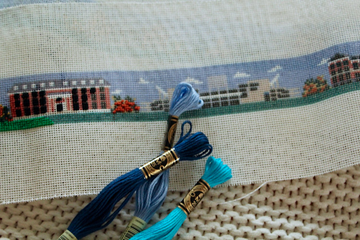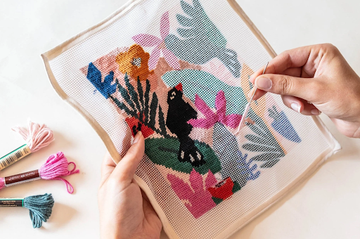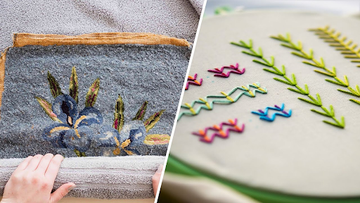Struggling to thread a needle? You’re not alone.
Even seasoned stitchers fumble with it, so don’t worry. Threading a needle seems like it should be easy. That’s until you actually try. If you’ve ever squinted, fumbled, or said a few choice words over a needle and thread, this guide is for you. It’s one of those simple tasks that can feel weirdly impossible, especially when you’re new to it or working with thicker thread like in needlepoint.
But don’t worry, once you get the hang of it, and maybe discover a few shortcuts, you’ll be threading like a pro in no time.
Summary: What You’ll Learn
This is your go-to guide on how to thread a needle the easy way. Whether you're just learning, returning to needlework after a break, or exploring needlepoint for the first time, this step-by-step breakdown will help you:
-
Choose the best needle for needlepoint
-
Use a needle threader tool the right way
-
Avoid frustrating threading mistakes
-
Learn needlepoint-specific threading tips
- Find beginner-friendly tools and kits
Who This Article is For
This guide is perfect for:
-
New stitchers trying to master the basics
-
Older crafters looking for eye-friendly methods
-
Needlepoint lovers dealing with thicker yarns
-
Anyone who’s had it with threading struggles
Supplies You’ll Need
Here’s what you’ll need before we jump into threading:
|
Item |
Why It Helps |
|
Needle |
The right size and type makes threading easier |
|
Thread |
Choose one that fits your needle’s eye |
|
Scissors |
Sharp ones help prevent fraying |
|
Needle threader tool |
Optional, but saves time and squinting |
|
Thread wax/stiffener |
Optional, but helps guide thread smoothly |
Tip: Keep your threading station well-lit. Natural light or a small craft lamp can make a big difference.
Types of Needles (With Needlepoint in Mind)
Needles aren’t one-size-fits-all. In needlepoint, you're typically working with thicker thread and open-weave canvas, which calls for specific needle types.
The Best Needle for Needlepoint
-
Tapestry Needle
Blunt tip with a large eye that is great for canvas work.
Sizes range from #18 to #26. Smaller numbers = larger needles.
-
Chenille Needles
Sharper than tapestry needles, but also have large eyes. Good for piercing felt or tightly woven fabric.
-
Crewel Needles
Fine point with smaller eyes. Better for embroidery but not ideal for needlepoint.
-
Beading Needles
Extra thin and long with a very small eye. Perfect for threading tiny seed beads, but not ideal for needlepoint. They're too fine for thicker threads and can bend easily on canvas.
For beginners: Try a #18 tapestry needle. It’s easy to thread and works well with most yarns or threads.
Choosing the Right Thread
Not all threads are created equal. In needlepoint, thicker, more textured threads are used to fill the canvas beautifully and hold their shape over time.
Recommended Threads for Needlepoint:
-
Persian wool: Soft, plump, and covers well
-
Pearl cotton: Smooth with a slight shine
-
Silk: Luxurious, but can be slippery
-
Embroidery floss: Great for detail or fine stitching
Pro Tip: Stick with a thread that glides through your needle and canvas without tugging. Test it before starting your full piece.
Threading a Needle: Step-by-Step
Now to the good stuff! Here’s how to thread a needle without the usual struggle.
Cut the Thread Cleanly
Use sharp scissors to snip the end of your thread at a slight angle. A clean cut prevents fraying and helps guide the thread through smoothly.
Moisten or Flatten the Tip
Lightly pinch the end of your thread to flatten it, or give it a small lick to stiffen it. Some people also use beeswax or thread conditioner to make it smoother.
Hold the Needle Steady
Hold the needle between your thumb and forefinger. Some prefer resting it on a table or using a pincushion to steady it.
Guide the Thread Through
Gently push the thread through the eye of the needle. If it resists, don’t force it. Try trimming again or switching to a larger needle.
Or Use a Needle Threader Tool
This handy gadget makes threading a needle almost effortless.
How to Use It:
-
Insert the wire loop through the needle’s eye.
-
Feed your thread through the loop.
-
Pull the loop back through the needle and the thread follows!
Looking for the best needle work tools? We’ve got them →
Common Mistakes to Watch Out For
Even the best stitchers hit snags. Here are a few common threading mistakes to avoid:
-
Fraying: Caused by blunt scissors or dry thread. Always cut clean.
-
Too-small needle eye: Don’t force thick thread through a tiny eye.
-
Tugging too hard: Might break or warp your thread.
-
Unraveled strands: Especially with floss, keep the ends even.
Fix-It Tip: If your thread keeps fraying, use a little wax or conditioner, it smooths things out fast.
Threading for Needlepoint: What’s Different?
Needlepoint isn't quite like sewing or embroidery, it’s a different vibe and requires some unique handling.
Key Differences:
-
Thicker threads mean you’ll need bigger needle eyes
-
Canvas material is more open-weave, not tight like fabric
-
Multiple strands are often used, especially with floss or silk
Helpful Threading Tips:
-
Cut shorter lengths (18–20 inches max) to avoid tangling
-
Keep strands flat with a laying tool or even just your fingers
-
Thread one strand at a time if combining colors or textures
Our Favorite Threading Tools from Atlantic Blue Canvas
We love tools that make crafting smoother and threading faster.
Recommended by Our Team:
-
Needlepoint Starter Kits: All-in-one kits for easy stitching
-
Needlepoint Thread Controller: Helps keep multiple strands neat and tangle-free while threading and stitching
-
Tapestry Needles: Blunt, strong, and made for thick threads
-
Canvas Grippers & Frames: For tension and comfort while stitching
Explore beginner-friendly tools and kits →
Recap: You’ve Got This
Threading a needle doesn’t have to be a battle. Whether you go old-school with a steady hand or grab a needle threader tool for backup, the trick is patience, the right supplies, and a little practice.
- Cut your thread cleanly
- Choose the right needle size
- Use threaders or wax to make life easier
Ready to start stitching? Shop our beginner-friendly needlepoint kits and accessories here.
FAQs
Why is it so hard to thread a needle sometimes?
The thread might be frayed, or the needle eye is just too small. Try trimming the thread again, moistening the end, or using a needle threader tool. It gets way easier with practice!
Can I use a sewing needle for needlepoint?
You technically can, but you’ll struggle. Sewing needles are sharper and have smaller eyes, which aren’t ideal for thick thread or canvas. Tapestry needles are a better fit. They’re blunt and thread-friendly.
What’s the best needle for beginners?
Start with a #18 or #20 tapestry needle. It’s easy to handle, simple to thread, and works great with the thicker threads used in needlepoint.
How do I stop my thread from fraying while threading the needle?
Fraying usually happens when the thread is too long or dry. Use sharp scissors to cut the end at an angle, and keep the length between 18–20 inches. You can also use a thread conditioner or beeswax to smooth it out before threading.
Is it better to use a single or double strand when threading?
Most people use a single strand of a thicker thread like Persian wool. If you’re using embroidery floss, you might want 2–3 strands for fuller coverage. Just make sure your needle eye can handle the thickness comfortably.
Why won’t my thread go through the needle even after trimming?
It might be the wrong needle size. Try switching to a needle with a larger eye, especially if you're using wool, silk, or multiple strands. If it still won’t go through, flatten the thread tip between your fingers or run it through wax to stiffen it slightly.
What’s the easiest way to thread a needle if I have shaky hands or poor eyesight?
Try using a needlepoint thread controller to manage your strands and steady your hands while threading. You can also hold the needle against a white background to better see the eye, or lay it on a pincushion for support.
How long should my thread be when starting a needlepoint project?
Keep your thread between 18 and 20 inches. Any longer, and it’s more likely to knot, twist, or fray. If you're working on a large section, just re-thread when needed, it’ll save you time in the long run.





